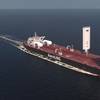Weak Oil Threatens US Export of LNG
Plunging global oil prices may turn hopes for cheap liquefied natural gas supplies from the United States into a costly disappointment for Asian buyers who have already invested billions of dollars in long-term contracts.
The 26 percent price slide since June to $85 a barrel exposes cracks in the assumption by utilities and industrial companies from Japan to India that cheap U.S. LNG would muscle into high-value Asian energy markets from 2016.
Oil prices form the backbone of LNG trade to Asia, because exporters outside the United States typically tie 25-year supply deals to crude oil prices. If prices continue to fall, these suppliers from Qatar to Australia will regain their edge over upstart U.S. producers.
"From the buyer's view, $80 oil makes oil-linked supplies less expensive ... it makes U.S. LNG relatively less attractive for buyers," said one industry source with a commercial focus on North American projects.
When Asian buyers signed for U.S. supply deals, the discount to rival oil-linked LNG supply was around $1.90 per mmBtu, but now that could be as low as 90 cents, and an oil price of $80 a barrel effectively results in a dead heat.
Asian buyers such as Korea Gas Corp., Tokyo Electric and India's Gail now face the potential for a glut of increasingly cheap oil-linked LNG.
Projects Suffer
The oil price drop has raised the possibility that some U.S. Gulf Coast LNG export plants may be mothballed before they ever get a chance to supply world markets.
Outside the United States as well, industry executives warn that sustained weak prices may delay or derail export projects that look marginal at $80-a-barrel oil.
Oil majors from Eni to Chevron are moving to gauge the profitability of liquefaction plants in a low oil price world. The result varies from project to project, because in some cases lower oil prices also bring down development price-tags.
For others nearing final investment decisions, bank creditors have vetted projects at oil prices from $70 a barrel. If prices fall toward that level, new projects could start to fold.
Some costly Australian projects will struggle to generate cash-flow even at current oil price levels, an executive developing an as-yet-unannounced LNG project in Canada said.
"The Australian projects would need to raise their level of oil indexation to survive, but I am not sure that would be possible until a few years after the start of exports," he said.
Others see Australian plants holding up a shade better.
"At $80 a barrel the returns are ordinary versus the project breakeven price; what a number of them would like is triple-figure oil to boost revenue," the first source said.
"There are a number of potential projects chasing investment that look marginal at $80 a barrel," he said.
In Canada, where high project development costs have made investors cautious, low oil prices will make progress even more difficult, another source said.
Smashed by Oil
Seen in the light of plus-$100 a barrel oil, projects to liquefy and export U.S. gas by ship promised major cost savings to Asian buyers and leverage to push down the cost of rival supply. That logic now risks backfiring on them.
"Once you get below $90 a barrel you start to get out of the money on U.S. LNG exports," said one LNG executive whose company is developing a major export project in east Africa.
"Buyers in Asia have this myopic view of the market by seeing the U.S. as a safe bet, and some of them are going to get smashed by what's coming," he said.
With oil at those levels, buyers may opt to fill their needs by turning to their long-term, oil-linked supplies and relegating the United States to a marginal swing supplier in Asia.
Cutting imports of U.S. gas is a possibility, but it is costly given that buyers under the typical contract have to pay a $150 million service charge annually to plant operators for every million tonnes of export capacity.
Given that U.S. regulators have so far approved 49 million tonnes of export rights, buyers are likely to try to divert the LNG to Europe and South America, where U.S. gas may find a niche.
Such a shift also could reshape European gas markets by lowering prices and squeezing out some Russian pipeline gas.
"If the LNG gets dumped on North-West Europe, it could weaken the hub price to near $6 a mmBtu by around 2020," energy consultant David Ledesma said. Prices now are at $10 per mmBtu.
But Japanese utilities are not geared up for fast-moving trading activity on the world gas markets, the east African LNG project executive said.
"Once those U.S. projects start to make losses, it will have a major impact on share prices."
(By Oleg Vukmanovic; editing by Jane Baird)













